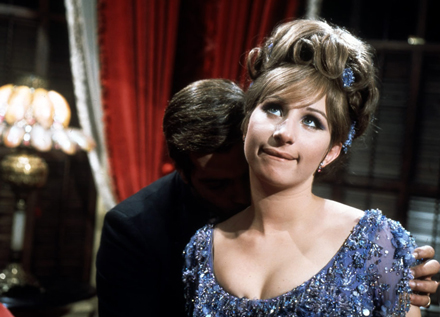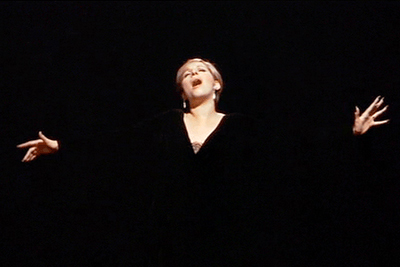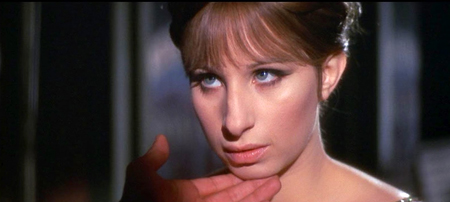
 |
|
|
|
As soon as Barbra Streisand's early career gained traction, she broke records by making smashing successes of every challenge she took on, and always in the very first attempt. Her greatest movie performance is still her screen debut in this extremely well-judged musical biography, that gently reshapes the story of comedienne-singer Fanny Brice to the needs of a Broadway musical and Ms. Streisand's special talents. The immensely popular Funny Girl won its young star a Best Actress Oscar in 1968. At the ceremony, actress Ingrid Bergman opened the fateful envelope and announced that the win was a tie -- between Barbra Streisand and Katharine Hepburn in The Lion in Winter. 
The rags-to-riches backstage story is special in that the star-to-be must fight an uphill battle against people that underestimate her appeal -- she's not a standard beauty. Fanny Brice (Barbra Streisand) is a clownish kid from Henry Street until she breaks into a vaudeville show run by Keeney (Frank Faylen). Almost immediately she's asked to join Ziegfeld's Follies and soon has creative differences with Florenz Ziegfeld himself (Walter Pidgeon): he wants to make her into a showgirl when she knows she's really a comiedienne who can sing. All of this is complicated by the attentions of high-rolling gambler Nicky Arnstein (Omar Sharif), who dotes on her yet frustrates her by only asking her out when he happens to bump into her at railway stations ... until he invites her to supper in a private room - with a bed. Pauline Kael used her review of Funny Girl to point out how wonderful a comedienne Streisand is, how she rattles off all those complicated lines with such good timing -- as if the actress hadn't had years of play performances to learn, alter and hone her comedy delivery. Streisand is a great Funny Girl and there's something entertaining in every scene. William Wyler wielded plenty of authority, but even he could see that letting Streisand have her way led to improvements in scenes. Directors thrive on talent and wise ones know when to stay out of the way. By 1968 Streisand had already achieved one major career goal after another, without reaching the limit of her abilities: singing in cabaret, performing on Broadway, guest star on TV shows, star and producer of her own TV specials, and the star of a major Broadway hit. Wyler made sure that nothing prevented the full expression of Streisand's singing voice on the screen. For the final "My Man" singing number, he allowed a retake in which she sung part of the song live, instead of to playback. It's just a shot of a chanteuse belting out a tune in medium close-up, but it electrified audiences. It's one of the best singing performances ever in a film. 
Then there's the issue of star personality, in which the ambitious Fanny Brice sometimes seems interchangeable with the immensely talented Streisand. Fanny Brice is an all-conquering heroine humbled only by complications in her love life. By the film's intermission she's well on the way to what seems to be total success. In the film's brief prologue, before Funny Girl slides into the flashback of Fanny Brice's story, we learn three things about Brice/Barbra. Looking in a mirror, she addresses herself with an ironic, "Hello gorgeous," that also emphasizes that her life's focus is on herself. Confronted with an empty auditorium, she pretends she's shooting an invisible audience with an invisible machine gun. Is the audience just a faceless enemy to Fanny? While sitting alone in the orchestra seats, she marvels at the fact that Flo Ziegfeld is patiently waiting for her in her dressing room, for as long as she wants him to. This is the way Brice likes things. None of it aligns with the philosopy of her later smash song: "People who need people are the luckiest people in the world." Fanny Brice desperately needs Nicky Arnstein, and it's a problem that makes her miserable. Streisand isn't afraid to present her Fanny as a pushy piece of work, who seems to know by instinct how to elbow herself into the spotlight. Her calculated cutes allow her to pull off tricks that would get any other showgirl strung up by her own garters, regardless of her talent. Fanny pretends that she can't rollerskate, a slick trick that allows her to usurp the role of comic star in what's supposed to be a group number. Time and again she seizes the day, which basically means taking it away from somebody else. Everything's about Fanny, always. She's a regular Tom Cruise character. Yet Streisand transcends such concerns. She redeems herself on screen by sheer star power. Her infectious charm and little Jewish Pixie schtick wins the day. She is adorable. Her line deliveries are inspired. She makes good use of broader comic shenanigans, like crossing her eyes. The real Fanny Brice surely would not have played well in 1968. Barbra adapts aspects of Brice's persona and makes them her own. The movie is a sophisticated star vehicle. Everything is designed to flatter Ms. Streisand first and reflect the period setting second. The attractive costumes and hairstyles suggest the 1920s, yet are totally suitable for a contemporary Streisand photo shoot. We wonder to what degree Streisand may have affected the look of Funny Girl. In scenes with the showgirls she stands out by not wearing colorful clothes; the nighttime Henry Street setting for the song People is designed almost in a drab single color. Yet most of the film is lit very high key and uses a clean, simple graphic style. 
The movie is not an ensemble piece. The Broadway show has been laid out like a flower arrangement with Streisand in dead center, and other characters entering only when really necessary. Smooth and smiling, the dark-eyed Omar Sharif is reverse arm candy, someone for Fanny to swoon over but not someone who will deflect audience attention from Barbra. Sharif actually keeps his end up quite well, despite his subdued reactions. Nick Arnstein is supposed to be a cool customer, a real smoothie, and he fulfills his mission. We even feel for him in the film's second half, when people begin to think of him as "Mr. Brice" and his self-image begins to erode. The first half of the film with its rise-to-fame and courtship scenes is the best because we are never quite prepared to accept this pair as doomed lovers. The second half skips rather rapidly through parenthood, the marital problems and Sharif's prison term, in a big hurry to get to the end number. Then Streisand's "My Man" breaks the fourth wall and simply assaults the film audience, as if we were in the first row of a concert. It's barely four minutes long, but it turns out to be so satisfying, our complaints dissolve away. Streisand has us in her pocket. The supporting cast is charming, although the unrelieved focus on Streisand reduces a lot of good actors to glorified spear carriers. Walter Pidgeon's Florenz Ziegfeld manages a dignified exasperation, stopping just short of tossing her out of his show. The next strongest impression but also the film's biggest casualty is the beautiful Anne Francis as Brice's showgirl buddy Georgia James. Francis hints at some interesting personality traits in her first couple of appearances, but her role seems to have been trimmed almost out of existence -- she gets only a little more emphasis than the other chorus girls. Was Francis too pretty? Too interesting? In the final cut she mainly holds telephones and acts surprised by Brice's erratic behavior. Francis and Pidgeon had of course played father and daughter ten years previously, in Forbidden Planet. Direct from Broadway, Kay Medford is solid but underused as Brice's mom Rose. Special note must be made of Mae Questel, simply for her voice. She was the vocal talent for Max Fleischer's original Betty Boop cartoons, and followed up that assignment by doing Olive Oyl's voice as well. 
Speaking of chorus girls, choreographer Herbert Ross recreates a Florenz Ziegfeld showgirl pageant that's almost intoxicating. With its swooning music opening, the Beautiful Reflection song opens on a glittering staircase of bejewelled women, creating an extreme statement of the worship of a certain kind of idealized beauty. For another sequence an entire ballet company performs a comic version of Swan Lake, with Tommy Rall dancing opposite Barbra. This is no quickie effort, as with the silly ballet in Columbia's 1963 Bye Bye Birdie. Actually a rather good natural dancer, Barbra mimes a few impressive ballet moves. For some reason, the slapstick sketch was cut short, and certainly looks that way. But a partial B&W original version still exists. Funny Girl doesn't always have the lavish feel of vintage musicals but it never seems cheap In the movie's second half the comedy gives ground to soapdish drama. As soon as Brice is installed in that mansion her wardrobe begins to deteriorate as well, until the 20s atmosphere is almost completely lost. Yet Streisand carries every scene and the film works extremely well. That's not an empty observation considering how poorly most of the musicals made between The Sound of Music ('65) and Cabaret ('72) turned out -- the majority are difficult to watch. The assurance required to pull off ambitious visual concepts is not to be sniffed at. Of special note is the idea of spreading Don't Rain on My Parade over a journey to catch a boat in the New York harbor. The sequence is nigh-on perfect, right down to the timing in the spectacular helicopter shot over New York harbor. A new movie would simply iron out any flaws with CGI work. Here we know that Barbara thought enough of her film to go to the trouble of hanging on to the rail of a tugboat churning through the waves ... it's not faked. Director William Wyler had a lot of help from Herbert Ross, who did the dance numbers and later graduated to directing for the so-so sequel, Funny Lady. 1 Funny Girl is such a musical delight that it's a shame that Ms. Streisand rushed into a string of starring roles that didn't stretch her abilities. She fought with director Gene Kelly on Hello, Dolly!; he seemed to be trying to remake Meet Me in St.Louis while Streisand was not the best fit for Dolly Levi, or the songs laid out for the character. Vincente Minnelli's creative juices were at low ebb for the freeze-dried psychedelics of On a Clear Day You Can See Forever, with its weak former-life flashbacks and even weaker leading man. At least the movie's title song gave Barbra a solid signature tune. Sony/Columbia Pictures's Blu-ray of Funny Girl reflects a new 4k restoration that pulls the maximum out of the colorful 1968 film, which always looked good on home video. Just the same, cinematographer Harry Stradling's clean lines and pure colors are really helped by the added contrast range and sharpness of HD. The two vintage featurettes Barbra in Hollywood and This is Streisand are the only extras. The featurettes look okay but both are flat transfers, even though the second was originally in 'Scope. I like bargain-priced Blu-rays as well as anyone, but Sony has missed an opportunity with this title: the superstar singer's legions of rabid fans would gladly spring for a quality special edition. Streisand reveres the memory of William Wyler and credits him with inspiring her to become a director herself; she'd surely have a lot to say about her movie debut.
On a scale of Excellent, Good, Fair, and Poor,
Funny Girl Blu-ray rates:
Footnote:
1. Streisand apparently liked
that tugboat image a lot, because she adapted it for the conclusion of her directorial debut Yentl.
Reviews on the Savant main site have additional credits information and are often updated and annotated with footnotes, reader input and graphics.
Review Staff | About DVD Talk | Newsletter Subscribe | Join DVD Talk Forum |
| ||||||||||||||||||